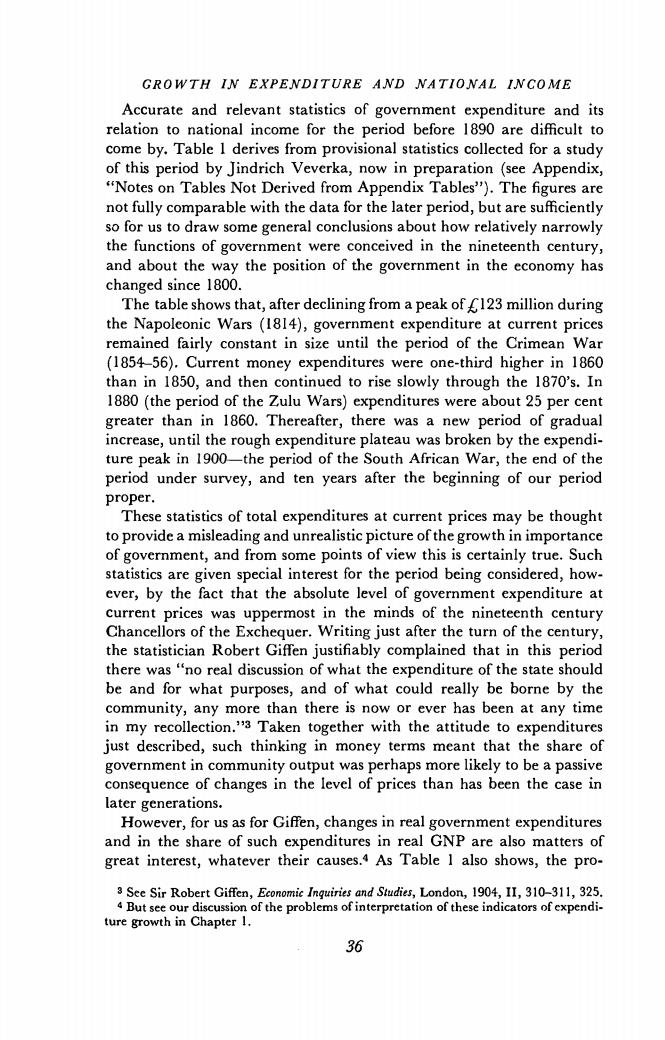正在加载图片...

GROWTH IN EXPENDITURE AND NATIONAL INCOME Accurate and relevant statistics of government expenditure and its difficult to come by.Table 1 derives from provisional statistics collected for a study of this period by Jindrich Veverka,now in preparation (see Appendix, "Notes on Tables Not Derived from Appendix Tables").The figures are coparable with the data fo th later period,bcentl some general conclusions ab out how relatively narrowly the functions of government were conceived in the nineteenth century, and about the way the position of the government in the economy has changed since 1800. The table shows that,after declining from a peak of 23 million during the Napoleo nic Wars (1814),goverr t expen diture a current prices remained fairly constant in size until the period of the Crimean War (1854-56).Current money expenditures were one-third higher in 1860 than in 1850,and then continued to rise slowly through the 1870's.In 1880(the period of the Zulu Wars)expenditures were about 25 per cent greater than in 1860.Thereafte ther was a new period of gradu increase,until the rough expenditure plateau was broken by the expendi ture peak in 1900-the period of the South African War,the end of the period under survey,and ten years after the beginning of our period Droper. These statistics of total ex nditures at cur ent prices may be thought toprovidea misleadi ng and unrea listic picture of the e growth i n importanc of government,and from some points of view this is certainly true.Such statistics are given special interest for the period being considered,how- ever,by the fact that the absolute level of government expenditure at curent prices was uppermost in the minds of the nineteenth century Writing it ust after th of the the statistician Robe t Giffen complai ned that in this perio there was"no real discussion of what the expenditure of the state should be and for what purposes,and of what could really be borne by the community,any more than there is now or ever has been at any time in my recollection."3 Taken together with the attitude to expenditures just described,such thinking in money terms meant that the share of government in aps likely to be a passive later generations. However,for us as for Giffen,changes in real government expenditures and in the share of such expenditures in real GNP are also matters of great interest,whatever their causes.As Table I also shows,the pro- 36 GROWTH IX EXPENDITURE AND NATIONAL INCOME Accurate and relevant statistics of government expenditure and its relation to national income for the period before 1890 are difficult to come by. Table 1 derives from provisional statistics collected for a study of this period by Jindrich Veverka, now in preparation (see Appendix, "Notes on Tables Not Derived from Appendix Tables"). The figures are not fully comparable with the data for the later period, but are sufficiently so for us to draw some general conclusions about how relatively narrowly the functions of government were conceived in the nineteenth century, and about the way the position of the government in the economy has changed since 1800. The table shows that, after declining from a peak ofL 123 million during the Napoleonic Wars (1814), government expenditure at current prices remained fairly constant in size until the period of the Crimean War (1854—56). Current money expenditures were one-third higher in 1860 than in 1850, and then continued to rise slowly through the 1870's. In 1880 (the period of the Zulu Wars) expenditures were about 25 per cent greater than in 1860. Thereafter, there was a new period of gradual increase, until the rough expenditure plateau was broken by the expenditure peak in 1900—the period of the South African War, the end of the period under survey, and ten years after the beginning of our period proper. These statistics of total expenditures at current prices may be thought to provide a misleading and unrealistic picture of the growth in importance of government, and from some points of view this is certainly true. Such statistics are given special interest for the period being considered, however, by the fact that the absolute level of government expenditure at current prices was uppermost in the minds of the nineteenth century Chancellors of the Exchequer. Writing just after the turn of the century, the statistician Robert Giffen justifiably complained that in this period there was "no real discussion of what the expenditure of the state should be and for what purposes, and of what could really be borne by the community, any more than there is now or ever has been at any time in my recollection."3 Taken together with the attitude to expenditures just described, such thinking in money terms meant that the share of government in community output was perhaps more likely to be a passive consequence of changes in the level of prices than has been the case in later generations. However, for us as for Giffen, changes in real government expenditures and in the share of such expenditures in real GNP are also matters of great interest, whatever their causes.4 As Table 1 also shows, the pro- 3 See Sir Robert Giffen, Economic Inquiries and Studies, London, 1904, II, 310—311, 325. 4 But see our discussion of the problems of interpretation of these indicators of expenditure growth in Chapter 1. 36